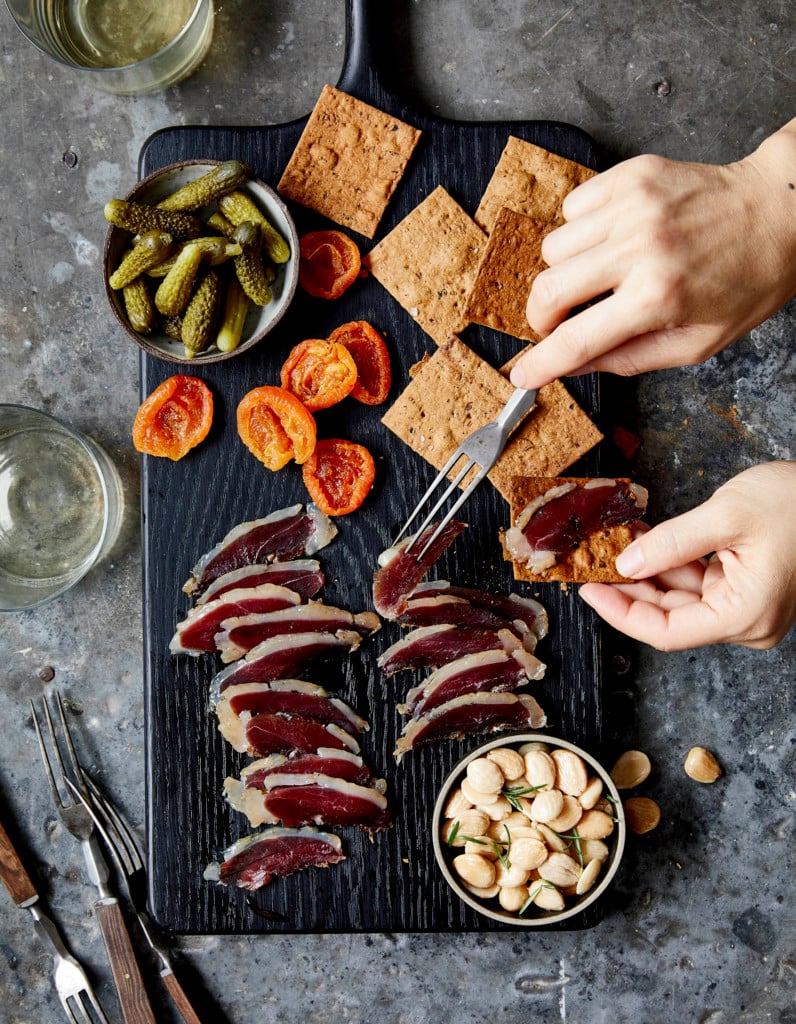Duck Breast Prosciutto

Makes 10–12 ounces
Allow at least 1 week to fully process this recipe that uses a method called “dry curing”.
This is about as effortless as home-cured meat can get. A little salt and sugar now will yield you a whole lot of flavor later. Not only is the flavor rich and fragrant, but the prosciutto also presents beautifully on a cutting board with crackers or crostini, aged cheese, pickles, and almonds. Save this for company, use it like you would pancetta to give flavor to roasted vegetables or pasta dishes, or serve it on a sandwich or a salad. It will be ready to eat after about 1 week, but I prefer to age it for 2 weeks or so in the refrigerator so that the texture is firmer.
2 duck breasts (about 8 ounces each)
½ cup light brown sugar
¼ cup kosher salt
2 teaspoons finely minced orange zest
2 teaspoons ground coriander
1 teaspoon ground sage
1 teaspoon freshly ground black pepper
- Diagonally score the skin side of the duck breasts by lightly drawing a very sharp knife across the skin and through the fat cap, making the cuts about ½ inch apart. Make a second set of diagonal cuts in the opposite direction so that the skin and fat are scored to make a diamond pattern.
- Pat the breasts dry with paper towels until they are a bit tacky to the touch. Place them in a shallow dish that can hold the duck flat in a single layer.
- Combine the sugar, salt, orange zest, coriander, sage, and pepper in a small bowl. Rub this cure all over both sides of the duck, including into the crevices of the skin. Place the duck back in the dish, skin side up. Cover the dish tightly with plastic wrap and refrigerate for 4 days. After a day or so, you’ll notice a lot of liquid in the bottom of the dish; this is normal and expected.
- Flip the duck breasts and cover the dish tightly with the plastic wrap again. Refrigerate for another 3 days.
- At this point, the duck should have a dark red color and feel firm all over, like a well-done steak. This means that your meat is cured. If it still feels very soft, flip the meat again and let it sit for another day or two.
- Preheat your oven to 200°F (90°C). Place a rack over a rimmed baking sheet.
- To ensure that your duck is safe to eat, place it on the rack, fat side up, in the preheated oven. Heat the duck for about 25 minutes, or until it reaches an internal temperature of 160°F (70°C).
- Rinse the duck well and pat it very dry. Slice it razor-thin before serving.
Storage
Wrap your finished duck breast in waxed paper or parchment paper and store it in the cheese compartment of your refrigerator. If it gets too firm and dried out, shield it from the elements in a well-sealed ziplock bag. Wrapped well, it will keep in the refrigerator for at least 6 months.
How to Zest Citrus Fruit
This recipe, and undoubtedly many others that will cross your kitchen counter, asks for finely minced zest. Zest is the very thin outermost layer of the fruit — the part with color. The white part just beneath is the pith, and this stuff is bitingly bitter and lacks the delicious and flavorful oils of the thin skin. When zesting, do your best to include as little of the pith as possible.
My favorite way to extract zest is with a Microplane. I don’t use many gadgets, but this is a goodie that’s both inexpensive and small to store. You will soon start using it for grating ginger, nutmeg, and chocolate for drinks, and for creating a snow flurry of cheese atop your pasta.
If you don’t have a Microplane on hand, any grater will do. Rub the orange against the grate in short bursts, turning it frequently, as this is the best way to stay away from the dreaded pith. And if all you have is a vegetable peeler, go forth and peel thinly, then use a knife to mince the zest to smithereens.


